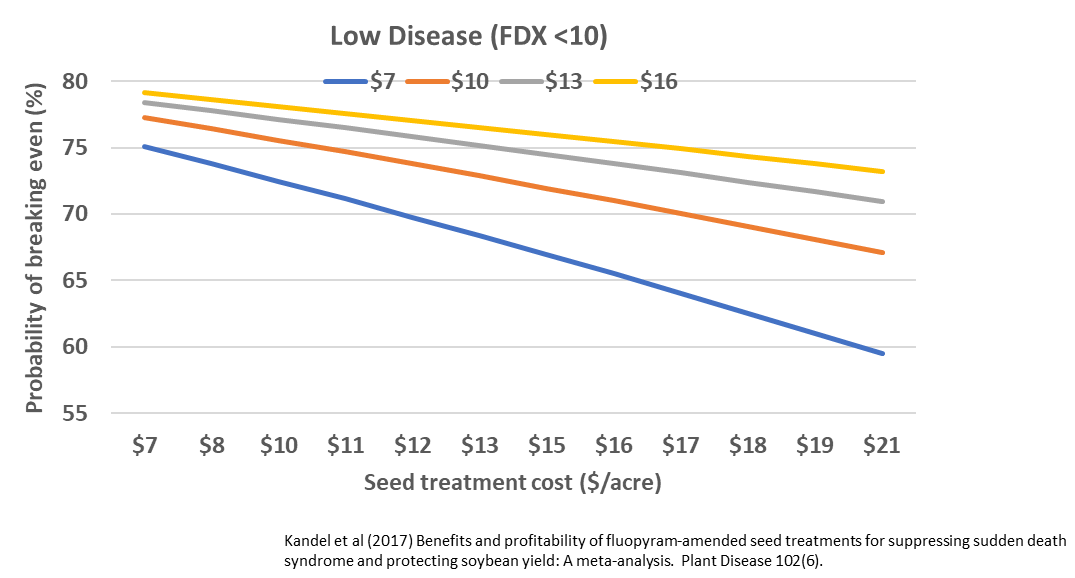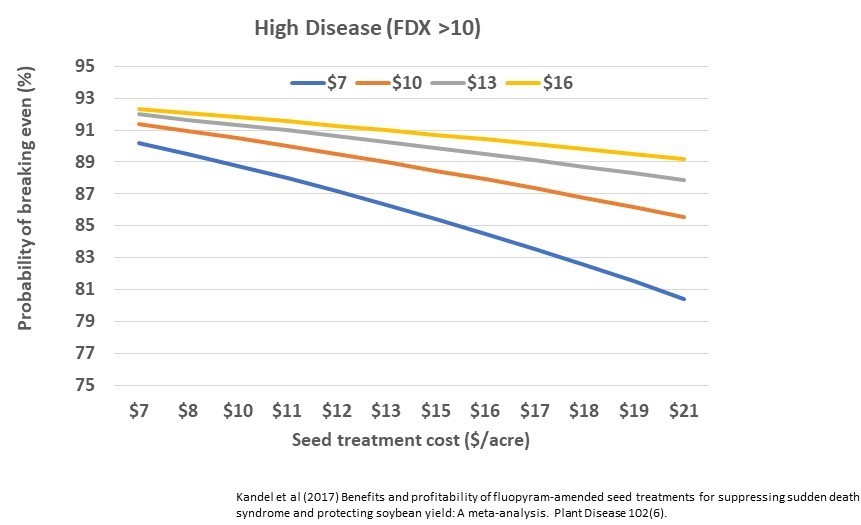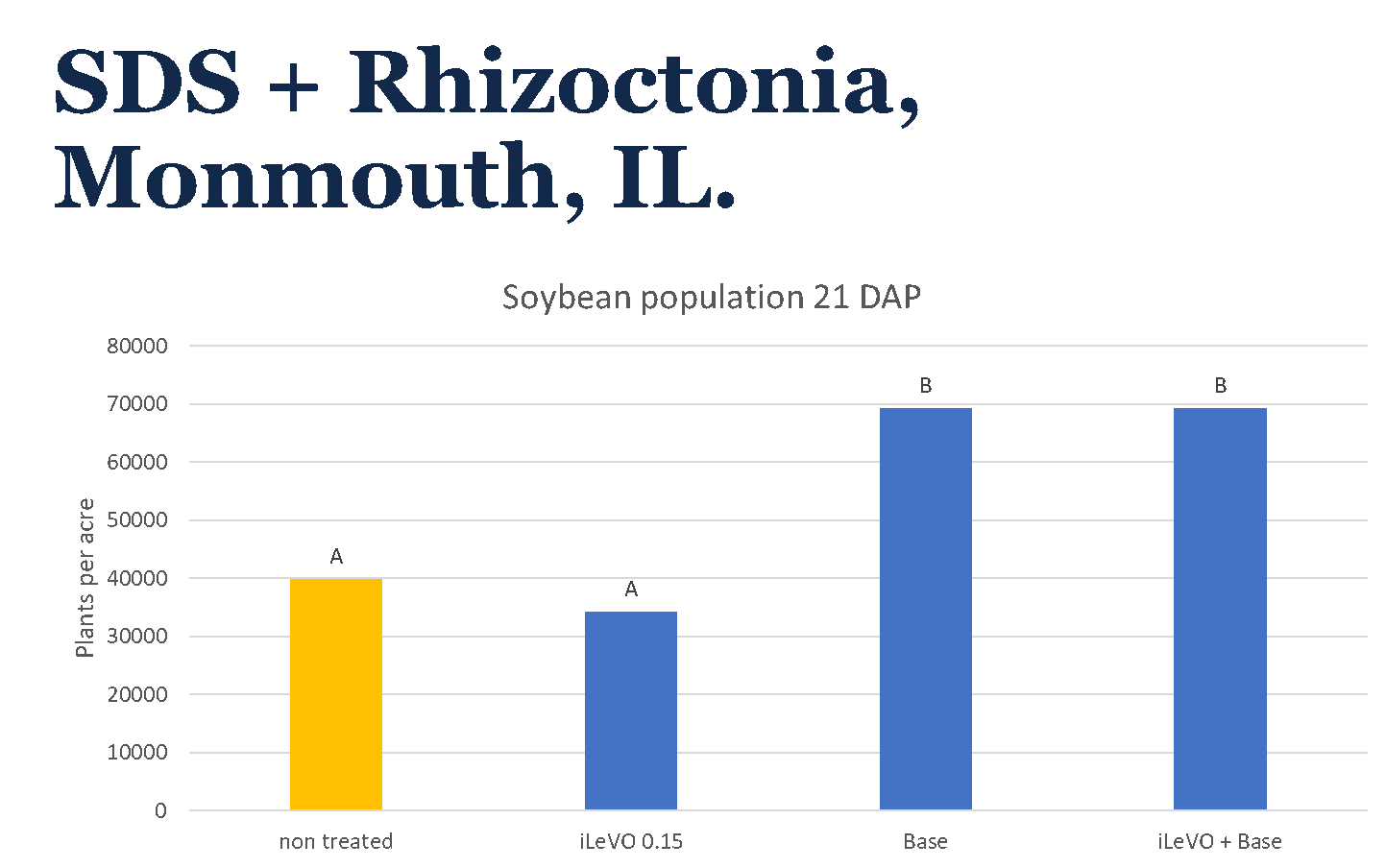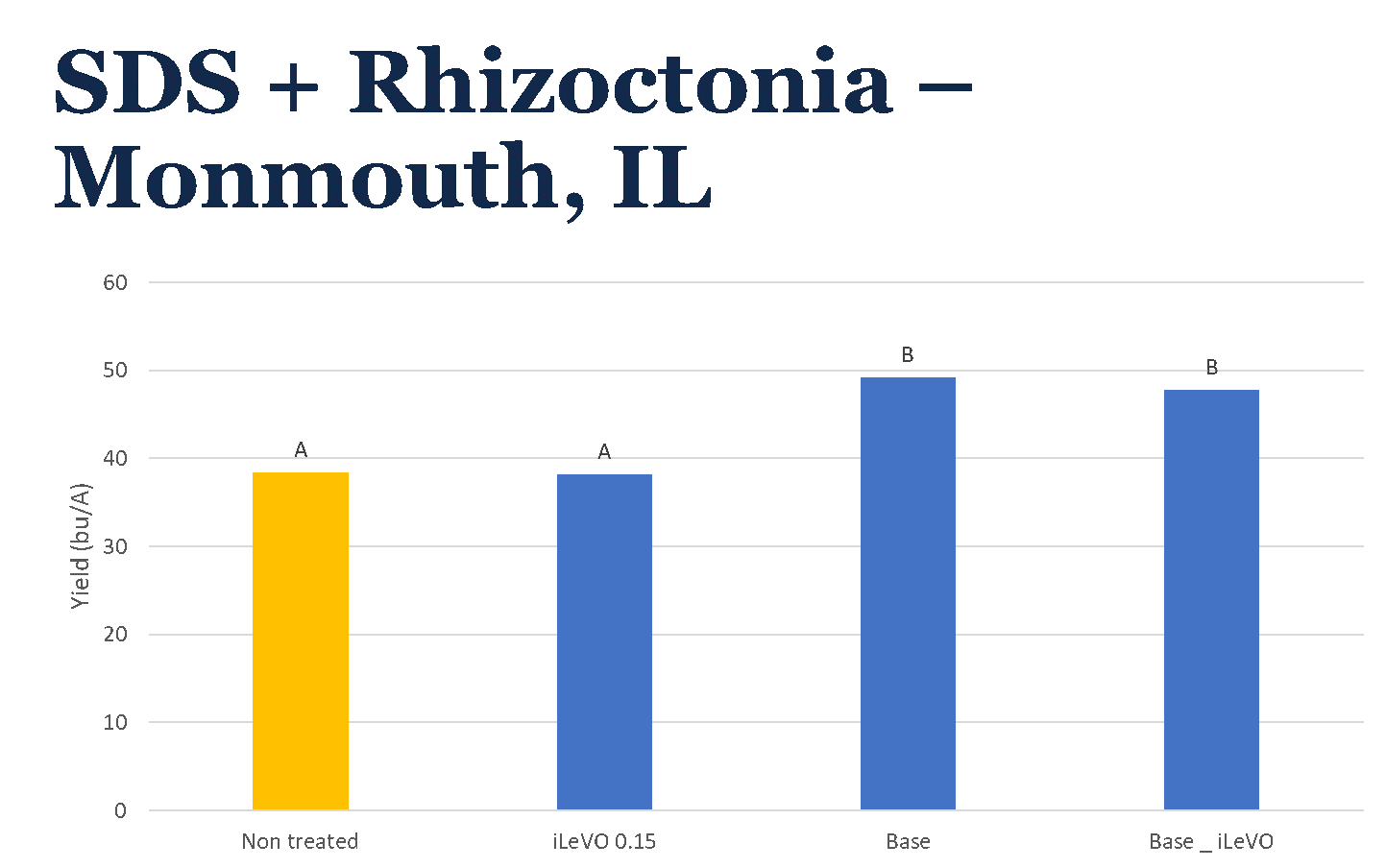Sudden death syndrome (SDS) is a soilborne fungal disease that historically has ranked within the top five most damaging diseases affecting soybeans in the northern United States and Ontario, Canada. In the United States and Canada, Fusarium virguliforme is the organism behind this disease. This fungus overwinters in fields within crop residue as resistant spores, allowing the pathogen to survive for multiple years in the absence of soybeans.
Infection of soybean roots by F. virguliforme is favored by cool conditions and wet, saturated soils. Plants that are not killed by initial infections will have their root systems colonized by the fungus, without any noticeable symptoms of disease.
The foliar stage of the disease is favored by fluctuating wet periods after the plants have started to set seed. At this point in time, some isolates of the fungus will produce a toxin, which is wicked up the plant in the xylem, or water conducting vessels. Consequently, the toxins accumulate in the leaves, causing interveinal necrosis and foliar blight. Initial infection by F. virguliforme can reduce stands and growth of soybeans, whereas late-season infections can reduce overall carbon budgets of the plants and subsequent grain fill. The overall result is reduced yields.
Disease Identification
Identification of SDS is not as straightforward as you would think. Early season infections are nearly impossible to diagnose, and often, seedling diseases exist as a complex of pathogens that love to cause seedling rots under wet conditions. Late-season interveinal chlorosis can be caused by several other diseases you may encounter in your fields, so it is important to know how to properly identify the disease.
SDS is characterized by interveinal chlorosis after pod set. Leaves may blight and fall off the plant. At the base of stems and soil line you may observe a blue growth, especially following periods of heavy rain later in the season. Roots will be rotted and overall fine root mass reduced when compared to unaffected plants. When you split the stem, the lower crown and stem will be light brown, with the center of the stem appearing unaffected.
Red crown rot is a new disease to Illinois and what I call the warm season cousin of SDS. The pathogen, Calonectria ilicicola, behaves in a similar fashion to F. virguliforme in many ways, but prefers warm (mid to upper 70’s-80’s) wet conditions. It causes pre–emergent and post emergent damping off and a black root rot early in the season. Plants surviving initial infections may be runty when compared to unaffected plants. If wet weather persists after pod set, the fungus produces a toxin that can accumulate in foliage, resulting in interveinal chlorosis similar to SDS. Although sometimes, leaves will simply become chlorotic and die. As plants deteriorate, a white mat of mycelia is often evident at the base of plants. Within this may be dark red bb’s, which are spore bearing structures for this fungus. When the lower crown is split, the center of the pith has an off gray appearance to it.
Stem canker can cause interveinal chlorosis under some conditions. These diseases are not root borne, and instead infect plants at the nodes. Dark cankers develop from the point of infection and spread up and down the stem. Often these cankers run up one side of the plant stem and contain black structures arranged in a linear fashion that run up the stem.
White mold also can produce foliar symptoms that can be confused with SDS. Symptoms typically originate from the buds, spread outwards and are covered by white, fluffy fungal growth. Inside and on the outside of the stems and pods pronounced black structures resembling mouse droppings (sclerotia) may be evident.
Brown stem rot is a soilborne disease that causes the most damage later in the season when conditions are cool. Split stems often contain a dry brown rot at the center of the stem.
Other things that may potentially cause similar foliar symptoms include nutrient deficiencies, toxicities and herbicide damage. The application of some foliar fungicides can also cause damage that may resemble foliar symptoms of SDS. The take home message is that interveinal chlorosis/necrosis on foliage is a symptom of SDS and also a range of other diseases and disorders.
Management
Management of SDS requires an integrated approach. Although no single practice can completely prevent SDS, there are ways that the amount of disease and its impact can be reduced.
Cultural Practices
Both the ability of F. virguliforme to overwinter several years in the absence of soybeans and the increasing evidence the fungus can grow and sporulate well on corn residue limit the utility of rotation on disease reduction. Research has shown that tillage does not impact SDS levels the following year. Cool, wet weather favors the growth of F. virguliforme. Consequently, it is often suggested that in situations where you have had serious SDS issues, one should avoid planting excessively early in the season. However, remember that yield potential tends to start dropping off when planting occurs after May 10. Regardless of planting date, the water is the major driving force in SDS development. If it is wet soon after planting, SDS can be a threat.
Cultivar selection
There is no complete resistance to the SDS pathogen currently available; however, cultivars can differ in their levels field resistance. In a recent multiyear/state project, Kandel, et al. (2017) demonstrated that on average, the use of field tolerant cultivars provided 74.1% less SDS and 13.1% greater yield than susceptible cultivars under SDS-favorable conditions. If you are planting into a field with a history of SDS, you should strongly consider one with good field tolerance to this disease.
Fungicide seed treatments
The use of fungicide seed treatments, particularly ILEVO®, have been shown to be effective in reducing SDS. In over 200 replicated trials across the United States and Ontario, Canada, the use of ILEVO improved yields by 7.6% compared to base seed treatments in fields with a history of SDS (Kandel, op. cit.). In this study, return on investment (ROI) for ILEVO was assessed across many grain price/product cost scenarios. In situations where severe SDS did not develop, an $11-16/A ILEVO cost paid approximately 65-70% of the time at $7 beans. However, in situations with severe SDS, that probability increased to roughly 85-89%.


Figure 1. Probability of breaking even for ILEVO seed treatment in low disease and severe disease environments.
During these tough economic times, some people have attempted to reduce input costs by using ILEVO, but not a base seed treatment. Unfortunately, in the world of seedling diseases, there are several other pathogens that can cause seedling diseases, including Pythium and Rhizoctonia. These organisms are not controlled by ILEVO. To illustrate this, we conducted a field trial in Monmouth, Ill., in 2018 where we assessed the impacts of a non-treated control, a base seed treatment, ILEVO, and base + ILEVO for disease, stands and yield. Plots were inoculated plots with F. virguliforme and Rhizoctonia. The field received rain a few days after planting, and then hit a hot dry spell for several weeks. Obviously, this was not an ideal situation for SDS, but was favorable to Rhizoctonia. As a result, stands and yields were both significantly improved over the non-treated controls and ILEVO only treated plots. The take home: do not skimp on your base seed treatments, as not every fungicide active ingredient is efficacious on every pathogen/disease. Currently, the NCERA-137 extension plant pathology team rates fluopyram (ILEVO) and pydiflumetofen (Saltro®) as very good for SDS suppression. You can see seed treatment ratings for various soybean seedling diseases at this link http://cropdisease.cropsciences.illinois.edu/?p=1060


Figure 2. Soybean populations and yields in response to seed treatment in Monmouth IL, 2018.
Managing SDS is not an easy thing to do, but as discussed there are steps you can take to minimize your risk as well as the impacts of this disease on your soybeans. New technologies and management strategies will continue to be developed and assessed in the future; however, at the present time remember to take an integrated approach to managing SDS in your fields to improve your chances of avoiding losses from this fungal disease.




 and then
and then